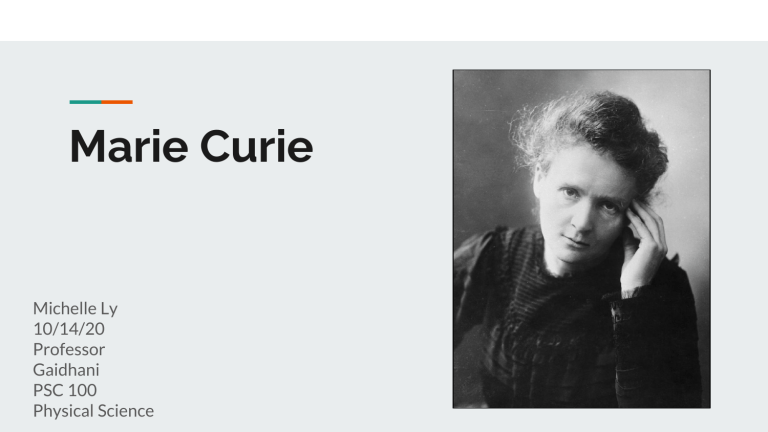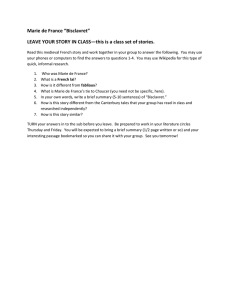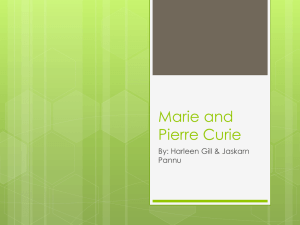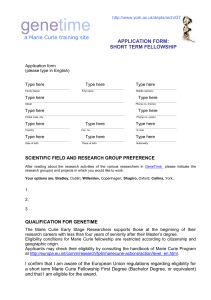
Marie Curie Michelle Ly 10/14/20 Professor Gaidhani PSC 100 Physical Science Early Life ● Marie Curie, born Marya Sklodowska in 1867, grew up in Poland to a family of prominent educators and as the youngest of five children. When Marya was ten years old, her mother passed away after a five year battle with tuberculosis. ● Three years later, her eldest sister died from typhus. ● Marya and her siblings were later enrolled in a secret school that integrated lessons on Polish heritage with other subjects where she excelled and graduated top of her class. Life in Paris ● After she graduated, Marya suffered a nervous breakdown at 15 years old and spent some time with their extended family in the countryside. ● In order to be able to receive a higher education, Marya and her sister Bronya knew they had to go abroad. ● Bronya headed to Paris for medical school first while Marya stayed behind and served a governess in the countryside. ● Once Bronya had a solid life in Paris, Marya joined her and began to attend the University of Paris studying physics, chemistry, and mathematics where she also changed her name from Manya to Marie. ● In 1893, Marie completed her master’s degree and earned another degree in mathematics the year later. ● She later received a grant to study magnetic properties and chemical compositions of steel where she met her husband, Pierre Curie. (now) Marie Curie ● They married in the summer of 1895 and it furthered her career due to their similar interests in science. ● That same year, Marie became fascinated by the scientific discoveries made by Wilhem Röntgen with the discovery of x-rays and Henri Becquerel’s discovery of radiation in uranium. ● However, once she became pregnant and expected her first child, she took time away from the laboratory until 1897 when her daughter Irene was born. ● Her dedication to her work never wavered even through her second pregnancy with her daughter Ève, even though many of her male colleagues thought she should stay home and take care of her children. Work of the Curies ● In April 1898, Marie found through her research that Becquerel rays were not just emitted by uranium. ● By testing every known element at the time and the effects it had to electrical conductivity of the air around it, she found that another element, thorium, also emitted Becquerel rays which was monumental for the scientific community. It meant that it was not elements that had (later named by Marie) radioactivity, it was atoms that carried them. ● Working endlessly and tirelessly to understand these other chemicals, the Curies eventually discovered another breakthrough, polonium in July of 1898. ● Five months after the discovery of polonium, the Curies extracted pure radium, which was another radioactive element they had found. The First (of many) Nobel Prizes ● In 1903, the Curies and Henri Becquerel were awarded the Nobel Prize in Physics for their contributions to discovering radiation. ● Because of her husband Pierre ardently defending his wife and her dedication to the work they had done together, she was listed as an honoree of the award, though many in the community thought she was just an assistant rather than a spearhead in the work they had done. ● At this point in time, Marie was the first woman to win a Nobel Prize which was a huge milestone for women in science. ● In the same year, she became the first woman in France to receive a doctorate due to her thesis being one of the greatest contributions to science. Tragedy and Scandal ● Though their life was seemingly perfect, Pierre passed away in 1906 by being run over by a carriage and left Marie devastated. ● The death of Pierre put Marie into another depression like that after her mother’s death causing Marie to throw herself into her work and becoming a professor of general physics making her the first woman to become a professor at a university, ● Curie would later that year win the Nobel Prize in Chemistry for her research on radium and polonium, though many did not want her at the ceremony due to scandal. ● Tabloids published articles saying that Marie was having an affair with a married student of her husbands, Paul Langevin. ● Though the world was saying negative things about her, Marie would, in the same year, win another Nobel Prize in Physics. World War I ● As time went on, World War I would break out in 1914, and Marie decided to aid in the war effort by establishing x-ray stations where battlefield doctors could treat wounded soldiers called “Little Curies.” ● She would later continue her work with the Austiran government and founded the Institut du Radium by raising funds in the United States. ● She received recognition for her work by receiving honorary degrees from Yale and Wellesley and many more. Her close work with radiation and radioactive elements would be huge breakthroughs in the scientific and medical fields, however, took a toll on her health. Death ● On July 4th, 1934, Marie died of aplastic anemia, where her body could not produce new blood cells due to her work and long-term exposure to radioactive elements. ● Marie Curie’s life was filled with huge highs and lows, however, her scientific accomplishments aided in the shift of women in science. ● Marie Curie is known as the most famous female in the scientific community because of her work and was awarded with numerous Nobel Prizes and distinctions, shifting the narrative that a woman’s place was in the home as a homemaker and nurturer. ● Her determination and drive changed the world and she died in search of scientific achievement and curiosity, making her one of the greatest scientists that ever lived. Bibliography ● Biography.com Editors. “Marie Curie.” Biography. N.p., 27 Feb. 2018. Web. 14 Oct. 2020. ● Julie Des Jardins. “Madame Curie’s Passion.” Smithsonian. Smithsonian.com, 1 Oct. 2011. Web. 14 Oct. 2020. ● Wikipedia Contributors. “Henri Becquerel.” Wikipedia. Wikimedia Foundation, 29 Apr. 2019. Web. 14 Oct. 2020. ● ---. “Marie Curie.” Wikipedia. Wikimedia Foundation, 27 Nov. 2018. Web. 14 Oct. 2020. ● ---. “Wilhelm Röntgen.” Wikipedia. Wikimedia Foundation, 15 Nov. 2019. Web. 14 Oct. 2020.




